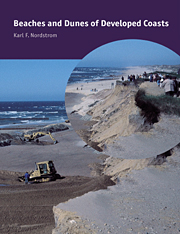Book contents
- Frontmatter
- Contents
- Preface
- Acknowledgements
- 1 The developed coastal landscape: temporal and spatial characteristics
- 2 Altering landforms to suit human needs
- 3 Replenishing landforms
- 4 Effects of structures on landforms and sediment availability
- 5 Characteristics of human-altered coastal landforms
- 6 Temporal scales of landscape change
- 7 Management programs
- 8 Maintaining and enhancing natural features in developed landscapes
- 9 Directions for geomorphological research
- References
- Index
1 - The developed coastal landscape: temporal and spatial characteristics
Published online by Cambridge University Press: 18 December 2009
- Frontmatter
- Contents
- Preface
- Acknowledgements
- 1 The developed coastal landscape: temporal and spatial characteristics
- 2 Altering landforms to suit human needs
- 3 Replenishing landforms
- 4 Effects of structures on landforms and sediment availability
- 5 Characteristics of human-altered coastal landforms
- 6 Temporal scales of landscape change
- 7 Management programs
- 8 Maintaining and enhancing natural features in developed landscapes
- 9 Directions for geomorphological research
- References
- Index
Summary
Introduction
Human-altered coasts vary greatly in appearance, from landscapes where human impact is significant but barely perceptible (Figure 1.1) to landscapes where cultural features visually dominate the landscape (Figure 1.2). No one would deny the prominent role that humans play in altering the coastal landscape (Walker 1984). The more difficult tasks involve identifying: (1) how human-altered landforms may be defined; (2) whether humans are or should be the dominant agent in landscape evolution; and (3) whether human needs or actions should determine the characteristics and values of the resulting landforms. These broad issues can be separated into several areas of investigation (Table 1.1) that are examined in detail. It is assumed here that the landforms of interest (beaches and dunes) and the habitats within them are desirable for both their natural and human values, and that it is better to have these landforms than not to have them. Human actions are then evaluated in terms of loss, gain or conversion of these landforms.
This chapter addresses the first two areas of investigation identified in Table 1.1 by providing a historical perspective on the human forces that drive coastal development and the processes and stages of alteration from natural shorelines to artifacts in attempts to maximize human values. The focus is on long-term and large-scale transformations of landscapes within which individual landforms are altered. The most obtrusive human modifications are highlighted, along with some of the economic and social reasons for the conversion. Evolution at the scale of individual landforms and at shorter temporal scales are evaluated in greater detail in subsequent chapters.
- Type
- Chapter
- Information
- Beaches and Dunes of Developed Coasts , pp. 1 - 26Publisher: Cambridge University PressPrint publication year: 2000
- 2
- Cited by



